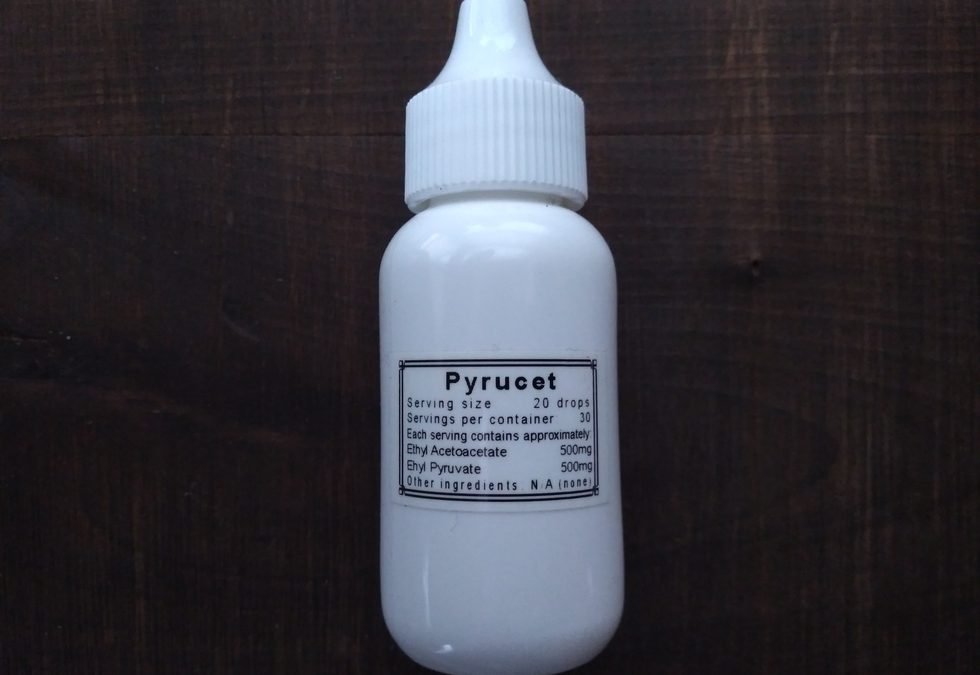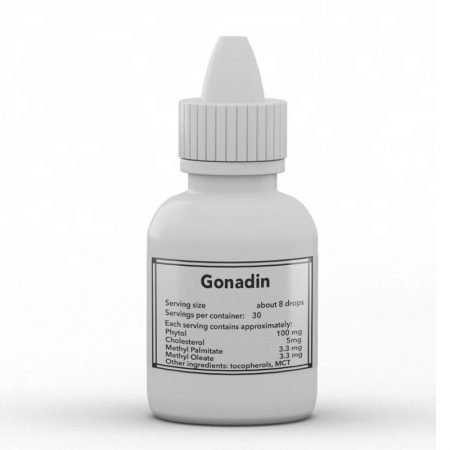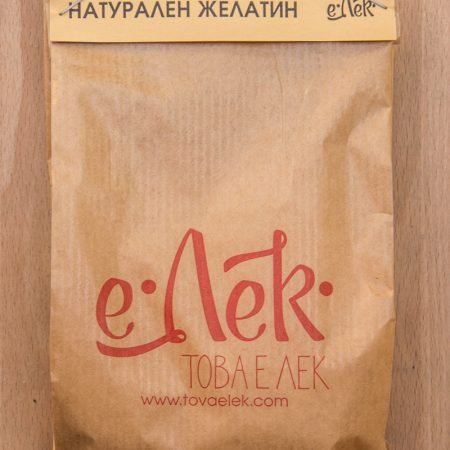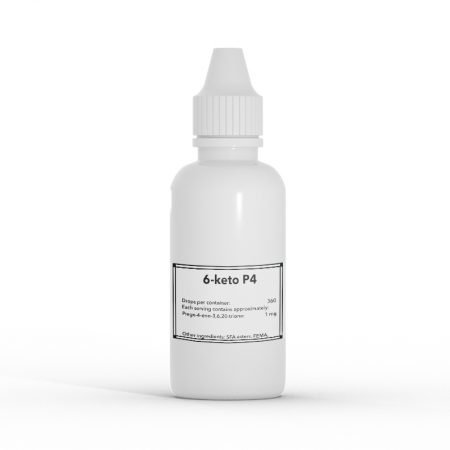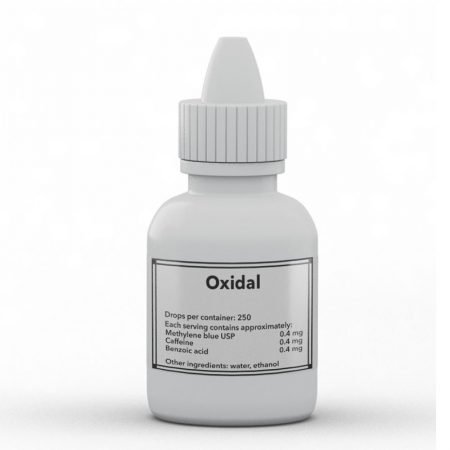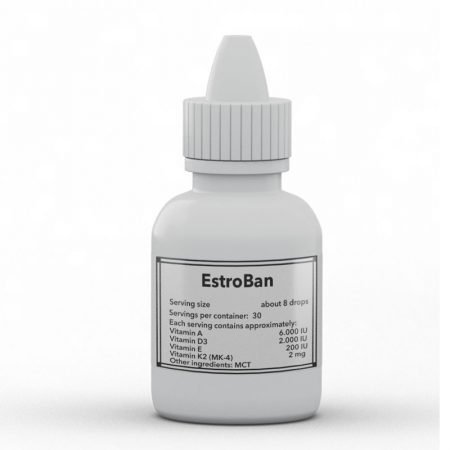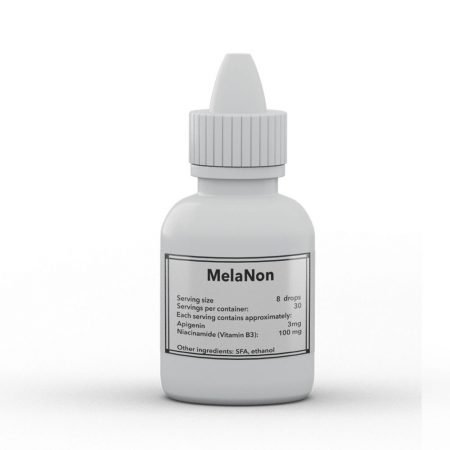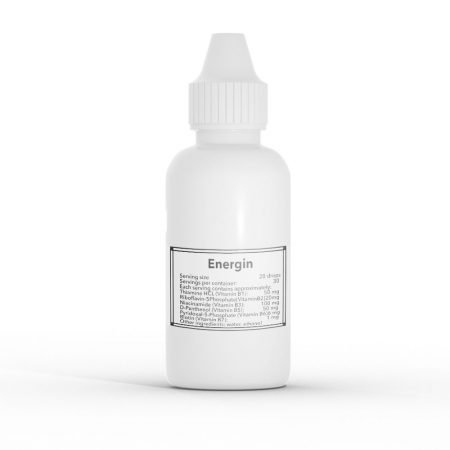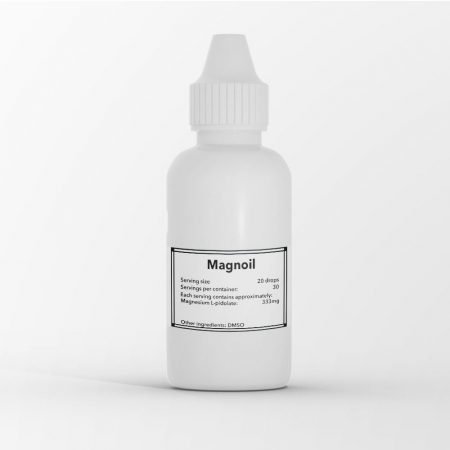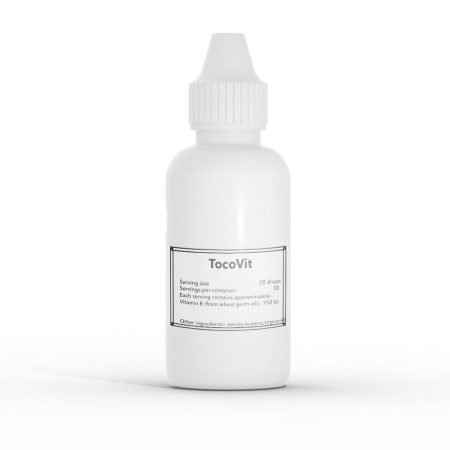Темата за ограничаване на окислението на мастните киселини и подтикване на процеса на окисление на глюкозата е доста важна за метаболитната теория за здравето. Д-р Рей Пийт е писал многократно по нея, споменавайки многобройни химични вещества, които могат да подобрят глюкозното окисление, а също и да редуцират прекомерното окисление на мастните киселини. Ниацинамид, аспирин, както и витамин Е са може би най-често споменаваните субстанции в това отношение. Въпреки това, всички тези вещества не инхибират окислението на мастните киселини директно. Те просто ограничават прекомерната липолиза. Съществуват субстанции, които директно инхибират тези процес и . Може би най-известния от тях е Милдронатът (Meldodium). Други такива са: триметазидин, етомоксир, ранолазин и др. За съжаление, с изключение на Милдроната, всички останали клинично използвани инхибитори на окислението на мастните киселини имат тежки странични ефекти, които ограничават тяхната употреба.
Не съществуват много подобни на Милдроната химични субстанции без токсични странични ефекти, а новооткритите не могат да бъдат използвани като продукт за нанасяне върху кожата, тъй като я дразнят. Въпреки това, съществуват две естествени съставки, които изглежда имат много обещаващи резултати като про-метаболитни субстанции.
Първото вещество е пируват, а второто – ацето-ацетат. Технически и двете представляват кетони. Пируватът е кето-киселина на аминокиселината аланин, а ацето-ацетатът е кетоновата версия на мастната киселина бутират. И двете съставки се употребяват като био маркери на редокс статуса под формата на тестове за съотношението пируват/лактат и ацето-ацетат/3β-хидроксибутират. И двете вещества са не само индикатори на редокс статуса, но също и негови модулатори – т. е. прилагането на което и да е от двете вещества променя редокс баланса в полза на окислението. Като резултат от това, съотношенията на NAD/NADH и GSSG/GSH също се повишават. Съотношението на първите две вещества няма нужда от представяне, но това на вторите две е от изключително значение при раковите заболявания. Раковите клетки акумулират огромни количества GSH (глутатион), който бива използван за защитата им от генерираните при химиотерапия реактивни кислородни форми. Всъщност, повишените нива на GSH се считат за първичен фактор при „химиотерапевтичната резистентност“. Големите фармацевтични компании влагат огромни средства в търсене на химични субстанции, които да понижат нивата на GSH.
Прилагането на висока доза ацето-ацетат само за един ден, понижава нивата на GSH до нула! По-умерена доза (която е налична в нашия продукт Pyrucet ) също понижава нивата му до нула след приемане от порядъка на 3-4 дена. Пируватът има същия ефект. Може би
най-интригуващият ефект и на пирувата и на ацетил-ацетата е възможността им да инхибират окислението на мастните киселини. И двете субстанции показват инхибиране поне 50% в концентрации, лесно постижими с единична доза Pyrucet.
Точният механизъм на действие за потискане на окислението на мастните киселини за двете химични вещества не е известен. В старо проучване се разкрива, че пируватът действа подобно на познатия етомоксир. В други изследвания се посочва, че пируватът и ацетил-ацетатът стимулират активността на ензима пируват-дехидрогеназа ( PDH), който е ограничаващото стъпало в процеса на окисление на глюкозата. Понижената активност на PDH е демонстрирана реално във всички хронични заболявания, особено диабет, рак, деменция, заболявания на черния дроб и бъбреците, сърдечно-съдови заболявания и др.
Веществото Дихлороацетат (DCA) не е много по-различно по структура от ацето-ацетата. Неговият първичен механизъм на действие е потискането на PDK (пируват-дехидрогеназа киназа), а оттам ре-активацията на PDH (пируват-дехидрогеназата). Големите фармацевтични компании много добре са запознати с ползите от активирането на PDH и са тествали няколко препарата върху животни с цел наблюдение дали активирането му може да лекува „не-метаболитни“ състояния като деменции, мускулни дистрофии, дори и амиотфорична латерална склероза. Все още няма изпитвания на активизиран PDH за лечение на ракови заболявания (като изключим неофициалните изследвания с дихлороацетат), но всички доказателства сочат в полза на PDH като огромен фактор при лечението им.
Проблемът при пирувата е, че е нестабилен в разтвор и също така, че трябва да бъде приложен в буквално високи дози, за да бъде наблюдаван полезен ефект. При изследванията върху хора обикновено се използват дози от 15g-50g пируват на ден. Ацето-ацетатът също е нестабилен, но при него поне и малки дози притежават силен ефект на окисление на про-глюкозата. Изследователското общество познава потенциала на пирувата още от 70те години и се опитва да намери алтернатива на чистия пируват, който да бъде стабилен и да дава полезни ефекти при по-малки дози. И са го отклили! Оказва се, че естер, познат като етил-пируват е доста стабилен при широк диапазон на температури и когато е миксиран с други химични вещества. Също така, естерът е по-липофилен от чистия пируват. Това е вероятното обяснение защо той е способен да упражнява същите полезни ефекти в дози 100 пъти по-малки от тези на чистия пируват.
В допълнение, множество изследвания, сръвняващи етил-пирувата и неговата чиста форма показват значителен добър ефект в полза на естера и нулев на чистия пируват. В няколко изследвания (изброени в референциите) правят опити да открият причината за отличителните ефекти между етил-пируват и чист пируват. В резултат се оказва, че ефектите на етил-пирувата са уникални и не се споделят нито от етанола, нито от пируват, приложени по отделно като отделни химични вещества.
Подобно на това, етил ацето-ацетатът също е стабилен и има подобни ефекти, за разлика от не-естерифицираната версия.
Някои от най-значимите полезни ефекти на етил-пирувата са: силно противовъзпалително средство в широк спектър, предотвратява спад на АТФ и енергийна дисфункция при множество тежки хронични състояния, антибактериален/анти-вирусен/ противогъбичен, невропротективен, хепатопротективен, нефропротективен, кардиопротективен, противораков, антисептичен, ендотоксин – блокер, имунопротективен, гонадопротективен агент и др.
Списъкът с благотворни ефекти е много дълъг, а количеството изследвания е смайващо. Едновременно е изненадващо и не толкова, че не сме чули нищо от медиите за този многообещаващ ендогенен метаболит. Като се имат предвид безбройните изследвания, в които се показват благотворните му ефекти върху широк спектър от състояния, може да се предположи, че причината да не се употребява клинично е генеричната му природа и непатенованост.
Стабилните липофилни естери на двата ендогенни метаболита очевидно притежават дълга поредица от ползотворни ефекти, а в същото време нямат реално никакви странични ефекти (поне в дозите, употребявани в описаните по-долу изследвания). Всъщност, етил-пируватът и етил ацето-ацетатът се определят от FDA (агенцията по храните и лекарствата на САЩ) като „общопризнати като безопасни“. Веществата се употребяват широко като овкусители в хранителната промишленост. Количествата, необходими за постигане на полезните им ефекти обаче, са далеч в по-големи дози, отколкото тези, които си набавяме от храната.
*******************************************************************************
Pyrucet е комбинация от етилови естери на ендогенните
метаболити/кетони пируват и ацето-ацетат. Многобройни изследвания показват, че тези
етилови естери са по-стабилни и по-липофилни от техните не-естерифицирани
версии. Доказани са техните ползотворни ефекти с много широк обхват при
проблеми с : глюкозния метаболизъм, окислението на мастните киселини, синтез на
АТФ, редокс статуса, възпалителните процеси, автоимунитета, бъбреците, сърцето,
черния дроб, мозъка, далака, тимуса, жлъчката, ставите и др.
https://raypeatforum.com/community/threads/pyrucet-liquid-ethyl-pyruvate-aceatoacetate-mix.27487/
-
 Pyrucet75.00лв.
Pyrucet75.00лв.
References:
1. Miscellaneous
Mutagenic
investigation of flavourings: dimethyl succinate, ethyl pyruvate and aconitic
acid are negative in the Salmonella/mammalian-microsome test. – PubMed – NCBI
(EP)
A 28-day
feeding study with ethyl acetoacetate in rats. – PubMed – NCBI (EA)
Ethyl
pyruvate improves skin flap survival after ischaemia reperfusion injury. –
PubMed – NCBI (EP)
Roles of
nitric oxide and ethyl pyruvate after peripheral nerve injury. – PubMed – NCBI
(EP)
“… Due to poor solubility and stability, therapeutic potential of pyruvate is
limited. Ethyl pyruvate (EP) is now considered as a suitable replacement of
pyruvate. In this paper, we will try to focus the effect of NO and EP in
Schwann cell dedifferentiation, proliferation, nerve degeneration, and
regeneration during Wallerian degeneration (WD) of peripheral nerve injury
along with their neuroprotective effects, cardiovascular functioning, support
in hepatic complication, etc.”
Inhibitory
effects of ethyl pyruvate on platelet aggregation and phosphatidylserine
exposure. – PubMed – NCBI (EP)
“…Ethyl pyruvate (EP) is a stable lipophilic pyruvate derivative. Studies
demonstrated that EP shows potent anti-oxidation, anti-inflammatory and
anti-coagulant effects. Inflammation and coagulation are closely interacted
with platelet activation.”
Acetoacetic
acid – Wikipedia
“…Acetoacetic acid (also diacetic acid) is the organic compound with the
formula CH3COCH2COOH. It is the simplest beta-keto acid group, and like other
members of this class, it is unstable. The methyl and ethyl esters, which are
quite stable, are produced on a large scale industrially as precursors to
dyes.”
Ethyl
pyruvate is a novel anti-inflammatory agent to treat multiple inflammatory
organ injuries. – PubMed – NCBI (EP)
Ethyl
pyruvate for the treatment of acetaminophen intoxication: alternative to
N-acetylcysteine? – PubMed – NCBI (EP)
“…Pyruvate, however, is unstable in aqueous solutions due to a rapid aldol-like
condensation reaction forming parapyruvate, a potent inhibitor of the Krebs
cycle blocking the α-ketoglutaric dehydrogenase [7]. This problem can be
circumvented by using the ethanol ester of pyruvate (that is, EP) – the effects
of which qualitatively resemble that of pyruvate, but which only require molar
doses that are lower by one to two orders of magnitude [7]. In addition to the
properties of pyruvate, EP also exerts anti-apoptotic effects, increases heme
oxygenase-1 expression, attenuates peroxynitrite-related DNA damage, and
stabilizes the hypoxia-inducible factor 1α via stimulation of the Krebs cycle.”
“…Ethyl pyruvate (EP) is a simple derivative of pyruvic acid, which is an
important endogenous metabolite that can scavenge reactive oxygen species
(ROS). Treatment with EP is able to ameliorate systemic inflammation and
multiple organ dysfunctions in multiple animal models, such as acute
pancreatitis, alcoholic liver injury, acute respiratory distress syndrome
(ARDS), acute viral myocarditis, acute kidney injury and sepsis. Recent studies
have demonstrated that prolonged treatment with EP can ameliorate experimental
ulcerative colitis and slow multiple tumor growth. It has become evident that
EP has pharmacological anti-inflammatory effect to inhibit multiple early
inflammatory cytokines and the late inflammatory cytokine HMGB1 release, and
the anti-tumor activity is likely associated with its anti-inflammatory effect.
EP has been tested in human volunteers and in a clinical trial of patients
undergoing cardiac surgery in USA and shown to be safe at clinical relevant
doses…”
Higher
hypochlorous acid scavenging activity of ethyl pyruvate compared to its sodium
salt. – PubMed – NCBI (EP)
“…The potential effect of ethanol was also evaluated, and hypochlorous acid was
used as an oxidant. Our data indicate the concentration-dependent scavenging
potency of both sodium and ethyl pyruvate, with the ester having higher
activity. This effect was not related to the presence of ethanol. Better
protection of the liver homogenate by ethyl pyruvate was also apparent, despite
the fact that cell membrane transport was omitted.”
Ethyl
pyruvate. – PubMed – NCBI
“…This ester was originally regarded as a way to administer pyruvate, while
avoiding some of the problems associated with the instability of pyruvate in
aqueous solutions. Increasingly, however, it is becoming apparent that certain
pyruvate esters, including ethyl pyruvate, have pharmacological effects, such
as suppression of inflammation, which are distinct from those exerted by
pyruvate anion. Ethyl pyruvate has been tested in human volunteers and shown to
be safe at clinically relevant doses. Ethyl pyruvate is a simple molecule that
has been shown to have salutary effects in numerous large and small animal
models of critical illness. It remains to be determined whether this ester can
be used successfully to treat human diseases.”
2. Metabolism
Inhibition
of free fatty acid oxidation by acetoacetate in normal dogs. – PubMed – NCBI
(EA)
“…The rate of turnover and oxidation of plasma free fatty acids (FFA) waa
measured in 7 normal anaesthetized dogs infused at a constant rate with
1-W-palmitate for 5 h. After a control period, sustained hyperketonaemia was
induced by infusing sodium aceto-acetate (AA). This produced a fall in plasma
FFA (33%) and in blood sugar (24%), without changes in immuno-reactive insulin
(IRI) concentrations. During the control period, the turnover rate of carbon of
FFA averaged 131 uat.C/kg/min, 32% of which were oxidized, thus supplying 17.7%
of the total CO, production. At the end of the AA infusion, the mean turnover
rate of FFA was reduced to 75 uat. C/kg/min; since only 13.9% of these were
oxidized, the contribution of FFA to total CO, production was reduced to 4.3%
.”
Effect
of pyruvate and acetoacetate on the metabolism of fatty acids by the perfused
rat heart. – PubMed – NCBI (EA + P)
“…About 75% of the fatty acids removed were oxidized to carbon dioxide
accounting, at this concentration of fatty acids in the perfusate, for 37% of
oxygen consumption of the heart…In the presence of 10mM pyruvate or
acetoacetate, the uptake of fatty acids from the medium was reduced
approximately 50% and the oxidation of the extracted acids was reduced further
so that only 25% of the fatty acids oxidized by the control group appeared as
carbon dioxide in the presence of competing substrate…The competing substrates,
thus, contributed 75%-85% to the fuel of the respiration and reduced the
contribution of the fatty acids to 8%-9% of the total respiration of the
heart…It may be of considerable interest to examine the competition between
pyruvate and free fatty acid over a range of concentrations bracketing
physiological concentrations of both substances…Both acetoacetate and pyruvate
can enter the tricarboxylic acid cycle without resort to a kinase, and this may
be one reason why they compete successfully with fatty acids which require the
action of adenosine triphosphate and a thiokinase.”
EFFECT
OF CARNITINE ON THE OXIDATION OF ALPHA-OXOGLUTARATE TO SUCCINATE IN THE
PRESENCE OF ACETOACETATE OR PYRUVATE. – PubMed – NCBI (EA)
Inhibition
of palmitoylcarnitine oxidation by pyruvate in rat heart mitochondria. – PubMed
– NCBI (P)
“…The oxidation of 1 -‘4C-palmitoylcarnitine by rat heart mitochondria has bean
measured by assessing both the disappearance of substrata and the appearance of
labelled products. Pyruvate inhibited palmitoylcarnitine oxidation by about
40%. Fifty percent inhibition occurred at about 20 umol/L pyruvate. The
inhibitory effect of pyruvate required entry of pyruvate into mitochondria
since it did not occur in the presence of a-cyano4hydroxycinnamic acid, an
inhibitor of the mitochondrial pyruvate transporter. “
“…Earlier work by Olson and by Evans et al had demonstrated significant
inhibition (40% to 50%) of palmitate oxidation in the retrogradely perfused
heart by lactate and by pyruvate. In addition, experiments by Harris et al5 and
by Hirche and Langor have shown that lactate could compete effectively with
fatty acids for oxidation by the heart in vivo. These observations have led us
to investigate the possible inhibition of fatty acid oxidation by pyruvate in
isolated rat heart mitochondria. We have demonstrated a significant inhibition
of fatty acid oxidation by pyruvate.”
Fatty
acid accumulation during ischemia and reperfusion: effects of pyruvate and
POCA, a carnitine palmitoyltransferase I inhibitor. – PubMed – NCBI (P)
“…During reperfusion, however, the tissue FA level dramatically increases,
indicating that the inhibitory effects of pyruvate and POCA on FA utilization
are additive. Pyruvate is known to activate pyruvate dehydrogenase and, hence,
to stimulate its own conversion to acetyl-CoA (Kobayashi and Neely, 1983). As a
consequence, the availability of mitochondrial free CoA will be diminished and
beta-oxidation becomes inhibited (Brosnan and Reid, 1985). In this manner
pyruvate probably inhibits the removal of FAs released from endogenous lipid
pools during reperfusion.”
“…In summary, the present findings show that POCA and pyruvate markedly
increase the FA content of reperfused hearts, most likely through inhibition of
the oxidation of FAs released from endogenous lipid pools.”
Studies on
inactivation of pyruvate dehydrogenase by palmitoylcarnitine oxidation in
isolated rat heart mitochondria. – PubMed – NCBI (P)
Single
pyruvate intake induces blood alkalization and modification of resting metabolism
in humans. – PubMed – NCBI (P)
“…CONCLUSION: Pyruvate intake induced mild alkalization in a sex-dependent
fashion. Moreover, it accelerated carbohydrate metabolism and delayed the rate
of glycerol appearance in the blood, but had no effect on the resting energy
expenditure. Furthermore, sodium salt seems to have had a greater effect on the
blood buffering level than calcium salt.”
Supplementation
of pyruvate prevents palmitate-induced impairment of glucose uptake in C2
myotubes. – PubMed – NCBI (P)
Pyruvate
reverses fatty-acid-induced depression of ventricular function and calcium
overload after hypothermia in guinea pig hearts. – PubMed – NCBI (P)
The
action of pyruvate on ethanol oxidation by intact isolated liver cells. –
PubMed – NCBI (P)
Stimulation
by acetoacetate of DPNH oxidation by liver mitochondria. – PubMed – NCBI
(EA)
Effect
of acetoacetate on the oxidation of reduced diphosphopyridine nucleotide by
intact rat liver mitochondria. – PubMed – NCBI (EA)
“…The oxidation of DPNH (NADH) by intact rat liver mitochondria, isolated in
0.25 M sucrose or 2.5% polyvinylpyrrolidone-0.25 M sucrose, was found to be
stimulated 4 to 6 times by catalytic quantities (0.3 to 1.0 uM) of acetoacetate
or D-b-hydroxybutyrate. Coupled phosphorylation was also stimulated, with P:O
ratios in the range of 1.5 to 2.2. The increased respiration was completely
inhibited by Amytal and antimycin A, and phosphate uptake abolished by
2,4-dinitrophenol. Catalytic quantities of succinate, a-ketoglutarate, malate,
citrate, glutamate, and pyruvate stimulated the endogenous respiration, but had
no effect on DPNH oxidation.”
Acetoacetate
induced dehydroascorbic acid accumulation in blood and tissues and its
prevention by glucose-cyclo-acetoacetate. – PubMed – NCBI (EA)
“…The effect of acetoacetate injections in doses of 500 mg/kg on ascorbic and
dehydroascorbic acid contents of blood and tissues, and their excretion in
urine, was studied. 2. Animals injected with aceto-acetate excrete more
dehydroascorbic acid and less ascorbic acid. Their tissues (liver, kidney,
spleen and adrenal) also accumulate more dehydroascorbic acid, and the amount
of ascorbic acid in them is diminished. 3. Glucose-cyclo-acetoacetate or its
hydrolysed product has been found to prevent this increased accumulation of
dehydroascorbic acid in blood and tissues. 4. Acetoacetate has been shown to
cause oxidation of ascorbic acid to dehydroascorbic acid in vitro in presence
of a few drops of CuSO4 solution at a faster rate than that in the control. 5.
The mechanism for prevention of acetoacetate induced accumulation of
dehydroascorbic acid by hydrolysed glucose-cyclo-acetoacetate has been
suggested.”
Progressive
depletion in the reduced glutathione content of the blood following
acetoacetate injections. – PubMed – NCBI
“…The experimental data presented indicate that acetoacetate causes a fall in
the blood GSH content, although it is not as sharp and rapid as is reported in
the case of alloxan (Leech & Bailey, 1945). It is only natural that this
should be so since acetoacetate is an intermediary fat metabolite which
normally occurs in very minute proportions in the system. Repeated daily
injection brings the blood GSH value to zero in 3-5 days, less time being
required with higher dose.”
Evidence
that glutathione depletion is a mechanism responsible for the anti-inflammatory
effects of ethyl pyruvate in cultured lipopolysaccharide-s… – PubMed – NCBI
(EP)
“…Although NAC increased GSH levels, EP had the opposite effect. The
anti-inflammatory effects of EP were partially reversed when RAW 264.7 cells
were treated with a cell-permeable GSH analog, glutathione ethyl ester. These
data support the view that the anti-inflammatory effects of EP are mediated, at
least in part, by the ability of EP to deplete cellular GSH stores. Moreover,
the findings presented here suggest that an unusual combination of biochemical
effects (inhibition of lipid peroxidation and GSH depletion) might account for
the anti-inflammatory effects of EP.”
Effect
of acetoacetate upon utilization of carbohydrate. – PubMed – NCBI (EA)
Hypochlorous
acid inhibition by acetoacetate: implications on neutrophil functions. – PubMed
– NCBI (EA)
Osmotonicity
of acetoacetate: possible implications for cerebral edema in diabetic
ketoacidosis. – PubMed – NCBI (EA)
Acetoacetate
and malate effects on succinate and energy production by O2-deprived liver
mitochondria supplied with 2-oxoglutarate. – PubMed – NCBI (EA)
[The
effect of acetoacetate on 3-hydroxybutyrate oxidation by rat liver
mitochondria]. – PubMed – NCBI (EA)
The
effect of acetoacetate on plasma insulin concentration. – PubMed – NCBI
(EA)
Effect
of ethyl pyruvate on skeletal muscle metabolism in rats fed on a high fat diet.
– PubMed – NCBI (EP)
Ethyl
pyruvate preserves IGF-I sensitivity toward mTOR substrates and protein
synthesis in C2C12 myotubes. – PubMed – NCBI (EP)
Ethyl
pyruvate stabilizes hypoxia-inducible factor 1 alpha via stimulation of the TCA
cycle. – PubMed – NCBI (EP)
The
effect of ethyl pyruvate on dapsone-induced methemoglobinemia in rats. – PubMed
– NCBI (EP)
3. Inflammation/Endotoxin/Sepsis/Trauma
Ethyl
pyruvate: a novel treatment for sepsis. – PubMed – NCBI (EP)
Ethyl
pyruvate: a novel anti-inflammatory agent. – PubMed – NCBI (EP)
Ethyl
pyruvate: a novel treatment for sepsis and shock. – PubMed – NCBI (EP)
Ethyl
pyruvate ameliorates inflammatory arthritis in mice. – PubMed – NCBI (EP)
Anti-encephalitogenic
effects of ethyl pyruvate are reflected in the central nervous system and the
gut. – PubMed – NCBI (EP)
Ethyl
pyruvate reverses development of Pseudomonas aeruginosa pneumonia during
sepsis-induced immunosuppression. – PubMed – NCBI (EP)
Ethyl
pyruvate inhibits the acetylation and release of HMGB1 via effects on
SIRT1/STAT signaling in LPS-activated RAW264.7 cells and peritoneal mac… –
PubMed – NCBI (EP)
Effects
of insulin combined with ethyl pyruvate on inflammatory response and oxidative
stress in multiple-organ dysfunction syndrome rats with seve… – PubMed – NCBI
(EP)
Effects
of N-acetylcysteine and ethyl pyruvate on ischemia-reperfusion injury in
experimental electrical burn model. – PubMed – NCBI (EP)
Ethyl
pyruvate protects against sepsis by regulating energy metabolism. – PubMed –
NCBI (EP)
“…RESULTS: Our results demonstrated that the administration of EP significantly
improved the survival rate and reduced intestinal histological alterations. EP
inhibited the plasma levels of IL-1β, IL-6, and tumor necrosis factor-α and
increased the IL-10 level. EP significantly inhibited the elevation of the
malondialdehyde, lactate, and lactate/pyruvate levels and enhanced the total
antioxidative capacity levels in the liver tissues. The downregulation of the
adenosine triphosphate (ATP), total adenylate, and energy charge levels in the
liver tissues was reversed in the septic mice treated with EP. CONCLUSION:
The results suggest that EP administration effectively modulates the energy
metabolism, which may be an important component in treatment of sepsis.”
Ethyl
pyruvate reduces hepatic mitochondrial swelling and dysfunction in a rat model
of sepsis. – PubMed – NCBI (EP)
Effects
of ethyl pyruvate on leukocyte-endothelial interactions in the mesenteric
microcirculation during early sepsis treatment. – PubMed – NCBI (EP)
Ethyl
pyruvate attenuates murine allergic rhinitis partly by decreasing high mobility
group box 1 release. – PubMed – NCBI (EP)
A
comparative analysis of multiple sclerosis-relevant anti-inflammatory
properties of ethyl pyruvate and dimethyl fumarate. – PubMed – NCBI (EP)
“…Production of two other proinflammatory cytokines, IL-6 and TNF, and NO was
suppressed by EP in macrophages and microglia. Reactive oxygen species production
in macrophages, microglia activation, and the development of Ag-presenting
phenotype in microglia and macrophages were constrained by EP. The release of
IL-6 was reduced in astrocytes. Finally, EP inhibited the activation of
transcription factor NF-κB in microglia and astrocytes. Most of these effects
were also found for DMF, implying that EP and DMF share common targets and
mechanisms of action. Importantly, EP had in vivo impact on experimental
autoimmune encephalomyelitis, an animal model of MS. Treatment with EP resulted
in delay and shortening of the first relapse, and lower clinical scores,
whereas the second attack was annihilated. Further studies on the possibility
to use EP as an MS therapeutic are warranted.”
“…Our results speak in favor of this possibility. Maybe the most favorable
facts are that EP reduced IFN-γ and IL-17 generation in human PBMCs, alleviated
EAE in rats, and even more it practically prevented the second relapse.”
Endoplasmic
reticulum stress mediates the anti-inflammatory effect of ethyl pyruvate in
endothelial cells. – PubMed – NCBI (EP)
Ethyl
pyruvate inhibits HMGB1 phosphorylation and release by chelating calcium. –
PubMed – NCBI (EP)
Ethyl
pyruvate decreases airway neutrophil infiltration partly through a high
mobility group box 1-dependent mechanism in a chemical-induced murine… –
PubMed – NCBI (EP)
Ethyl
pyruvate diminishes the inflammatory response to lipopolysaccharide infusion in
horses. – PubMed – NCBI (EP)
Ethyl
pyruvate ameliorates endotoxin-induced corneal inflammation. – PubMed – NCBI
(EP)
Ethyl
pyruvate attenuates formalin-induced inflammatory nociception by inhibiting
neuronal ERK phosphorylation. – PubMed – NCBI (EP)
Ethyl
pyruvate induces heme oxygenase-1 through p38 mitogen-activated protein kinase
activation by depletion of glutathione in RAW 264.7 cells and … – PubMed –
NCBI (EP)
[Ethyl
pyruvate inhibited HMGB1 expression induced by LPS in macrophages]. – PubMed –
NCBI (EP)
Preventive
effects of ethyl pyruvate on endotoxin-induced uveitis in rats. – PubMed – NCBI
(EP)
Preliminary
safety and biological efficacy studies of ethyl pyruvate in normal mature
horses. – PubMed – NCBI (EP)
Ethyl
pyruvate decreases proinflammatory gene expression in
lipopolysaccharide-stimulated equine monocytes. – PubMed – NCBI (EP)
In vivo
anticoagulant effect of ethyl pyruvate in endotoxemic rats. – PubMed – NCBI
(EP)
Ethyl
pyruvate therapy attenuates experimental severe arthritis caused by type II
collagen (CII) in the mouse (CIA). – PubMed – NCBI (EP)
Interaction
of ethyl pyruvate in vitro with NF-κB subunits, RelA and p50. – PubMed – NCBI
(EP)
Ethyl
pyruvate diminishes the endotoxin-induced inflammatory response of bovine
mammary endothelial cells. – PubMed – NCBI (EP)
Ethyl
pyruvate downregulates tumor necrosis factor alpha and interleukin (IL)-6 and
upregulates IL-10 in lipopolysaccharide-stimulated canine perip… – PubMed –
NCBI (EP)
Inhibition
by ethyl pyruvate of the nuclear translocation of nuclear factor-kappaB in
cultured lung epithelial cells. – PubMed – NCBI (EP)
Ethyl
pyruvate prevents inflammatory responses and organ damage during resuscitation
in porcine hemorrhage. – PubMed – NCBI (EP)
[Effects
of ethyl pyruvate on injuries of sepsis in mice]. – PubMed – NCBI (EP)
Can we
predict the effects of NF-kappaB inhibition in sepsis? Studies with
parthenolide and ethyl pyruvate. – PubMed – NCBI (EP)
Ethyl
pyruvate decreases HMGB1 release and ameliorates murine colitis. – PubMed –
NCBI (EP)
Effect
of ethyl pyruvate on physical and immunological barriers of the small intestine
in a rat model of sepsis. – PubMed – NCBI (EP)
Ethyl
pyruvate improves survival in awake hemorrhage. – PubMed – NCBI (EP)
Ethyl
pyruvate reduces the development of zymosan-induced generalized inflammation in
mice. – PubMed – NCBI (EP)
Ethyl
pyruvate and ethyl lactate down-regulate the production of pro-inflammatory
cytokines and modulate expression of immune receptors. – PubMed – NCBI (EP)
Ethyl
pyruvate modulates acute inflammatory reactions in human endothelial cells in
relation to the NF-kappaB pathway. – PubMed – NCBI (EP)
Protective
effects of ethyl pyruvate treatment on paraquat-intoxicated rats. – PubMed –
NCBI (EP)
[Protective
effect of ethyl pyruvate on barrier function of intestinal mucosa in dogs with
septic shock]. – PubMed – NCBI (EP)
[Effect
of ethyl pyruvate on indices of tissue oxygenation and perfusion in dogs with
septic shock]. – PubMed – NCBI (EP)
Ethyl
pyruvate, a potentially effective mitigator of damage after total-body
irradiation. – PubMed – NCBI (EP)
Protective
effect of ethyl pyruvate on msP rat leukocytes damaged by alcohol intake. –
PubMed – NCBI (EP)
Beneficial
effects of ethyl pyruvate in septic shock from peritonitis. – PubMed – NCBI
(EP)
Ethyl
pyruvate exerts combined anti-inflammatory and anticoagulant effects on human
monocytic cells. – PubMed – NCBI (EP)
[Effect
of treatment with ethyl pyruvate on multiple organ dysfunction and mortality
following delayed resuscitation after burn injury in rat]. – PubMed – NCBI
(EP)
Ethyl
pyruvate improves systemic and hepatosplanchnic hemodynamics and prevents lipid
peroxidation in a porcine model of resuscitated hyperdynamic … – PubMed –
NCBI (EP)
[Effects
of ethyl pyruvate on splenocyte proliferation and apoptosis in burn rats with
delayed resuscitation]. – PubMed – NCBI (EP)
[Effects
of ethyl pyruvate on cell-mediated immune function in rats with delayed
resuscitation after burn injury]. – PubMed – NCBI (EP)
Ethyl
pyruvate inhibits nuclear factor-kappaB-dependent signaling by directly
targeting p65. – PubMed – NCBI (EP)
Ringer’s
ethyl pyruvate solution: a novel resuscitation fluid for the treatment of
hemorrhagic shock and sepsis. – PubMed – NCBI (EP)
Ethyl
pyruvate: a novel anti-inflammatory agent. – PubMed – NCBI (EP)
Ethyl
pyruvate ameliorates intestinal epithelial barrier dysfunction in endotoxemic
mice and immunostimulated caco-2 enterocytic monolayers. – PubMed – NCBI
(EP)
Resuscitation
with Ringer’s ethyl pyruvate solution prolongs survival and modulates plasma
cytokine and nitrite/nitrate concentrations in a rat mod… – PubMed – NCBI
(EP)
Ethyl
pyruvate prevents lethality in mice with established lethal sepsis and systemic
inflammation. – PubMed – NCBI (EP)
Resuscitation
from hemorrhagic shock with Ringer’s ethyl pyruvate solution improves survival
and ameliorates intestinal mucosal hyperpermeability i… – PubMed – NCBI
(EP)
Ethyl
pyruvate modulates inflammatory gene expression in mice subjected to
hemorrhagic shock. – PubMed – NCBI (EP)
Reactive
oxygen species as mediators of organ dysfunction caused by sepsis, acute
respiratory distress syndrome, or hemorrhagic shock: potential be… – PubMed –
NCBI (EP)
Ringer’s
ethyl pyruvate solution: a novel resuscitation fluid. – PubMed – NCBI (EP)
4. CVD
Acetoacetate
augments beta-adrenergic inotropism of stunned myocardium by an antioxidant
mechanism. – PubMed – NCBI (EA)
Ethyl
pyruvate: A promising feasible therapeutic approach for myocardial
ischemia-reperfusion injury under both normoglycemia and hyperglycemia. –
PubMed – NCBI (EP)
Ethyl
pyruvate attenuates myocardial ischemia-reperfusion injury exacerbated by
hyperglycemia via retained inhibitory effect on HMGB1. – PubMed – NCBI (EP)
Ethyl
pyruvate inhibits oxidation of LDL in vitro and attenuates oxLDL toxicity in
EA.hy926 cells. – PubMed – NCBI (EP)
Ethyl
pyruvate protects PC12 cells from oxygen-glucose deprivation: A potential role
in ischemic cerebrovascular disease. – PubMed – NCBI (EP)
Anti-apoptotic
and myocardial protective effects of ethyl pyruvate after regional
ischaemia/reperfusion myocardial damage in an in vivo rat model. – PubMed –
NCBI (EP)
Impact
of ethyl pyruvate on Adriamycin-induced cardiomyopathy in rats. – PubMed – NCBI
(EP)
Effects
of Ethyl Pyruvate in Preventing the Development of Diet-induced Atherosclerosis
by Blocking the HMGB1 Expression in ApoE-Deficient Mice. – PubMed – NCBI
(EP)
Role of
high-mobility group box-1 in myocardial ischemia/reperfusion injury and the
effect of ethyl pyruvate. – PubMed – NCBI (EP)
Effects
of ethyl pyruvate on cardiac function recovery and apoptosis reduction after
global cold ischemia and reperfusion. – PubMed – NCBI (EP)
Ethyl
pyruvate prevents methyglyoxal-induced retinal vascular injury in rats. –
PubMed – NCBI (EP)
Ethyl
pyruvate reduces myocardial ischemia and reperfusion injury by inhibiting high
mobility group box 1 protein in rats. – PubMed – NCBI (EP)
Ethyl
pyruvate has anti-inflammatory and delayed myocardial protective effects after
regional ischemia/reperfusion injury. – PubMed – NCBI (EP)
Ethyl
pyruvate enhances intra-resuscitation hemodynamics in prolonged ventricular
fibrillation arrest. – PubMed – NCBI (EP)
Effects
of ethyl pyruvate on myocardial apoptosis and expression of Bcl-2 and Bax
proteins after ischemia-reperfusion in rats. – PubMed – NCBI (EP)
Ethyl
pyruvate enhances ATP levels, reduces oxidative stress and preserves cardiac
function in a rat model of off-pump coronary bypass. – PubMed – NCBI (EP)
Ethyl
pyruvate preserves cardiac function and attenuates oxidative injury after
prolonged myocardial ischemia. – PubMed – NCBI (EP)
5. GI/Liver/Kidney/Pancreas/Lungs
Prevention
of maleate-induced tubular dysfunction by acetoacetate. – PubMed – NCBI
(EA)
Ethyl
pyruvate and analogs as potential treatments for acute pancreatitis: A review
of in vitro and in vivo studies. – PubMed – NCBI (EP)
Prophylactic
effect of ethyl pyruvate on renal ischemia/reperfusion injury mediated through
oxidative stress. – PubMed – NCBI (EP)
Ethyl
Pyruvate Attenuates CaCl2-Induced Tubular Epithelial Cell Injury by Inhibiting
Autophagy and Inflammatory Responses. – PubMed – NCBI (EP)
Ethyl pyruvate
can alleviate alcoholic liver disease through inhibiting Nrf2 signaling
pathway. – PubMed – NCBI (EP)
Ethyl
pyruvate attenuates acetaminophen-induced liver injury and prevents cellular
injury induced by N-acetyl-p-benzoquinone imine. – PubMed – NCBI (EP)
Ethyl
Pyruvate Improves Pulmonary Function in Mice with Bleomycin-induced Lung Injury
as Monitored with Hyperpolarized 129Xe MR Imaging. – PubMed – NCBI (EP)
Ethyl
pyruvate ameliorates hepatic injury following blunt chest trauma and
hemorrhagic shock by reducing local inflammation, NF-kappaB activation a… –
PubMed – NCBI (EP)
Ethyl
pyruvate is renoprotective against ischemia-reperfusion injury under
hyperglycemia. – PubMed – NCBI (EP)
Ethyl
pyruvate reduces acute lung damage following trauma and hemorrhagic shock via
inhibition of NF-κB and HMGB1. – PubMed – NCBI (EP)
Hepatoprotective
effects of ethyl pyruvate against CCl4-induced hepatic fibrosis via inhibition
of TLR4/NF-κB signaling and up-regulation of MMPs/T… – PubMed – NCBI (EP)
Ethyl
pyruvate alleviates radiation-induced lung injury in mice. – PubMed – NCBI
(EP)
The
potential beneficial effects of ethyl pyruvate on diabetic nephropathy: an
experimental and ultrastructural study. – PubMed – NCBI (EP)
Protective
effects of ethyl pyruvate on lipopolysaccharide‑induced acute lung injury
through inhibition of autophagy in neutrophils. – PubMed – NCBI (EP)
Treatment
response of ethyl pyruvate in a mouse model of chronic obstructive pulmonary
disease studied by hyperpolarized 129 Xe MRI. – PubMed – NCBI (EP)
Intratracheal
instillation of ethyl pyruvate nanoparticles prevents the development of
shunt-flow-induced pulmonary arterial hypertension in a rat … – PubMed – NCBI
(EP)
Preventive
Effect of Ethyl Pyruvate on Postoperative Adhesion Formation Following
Abdominal Surgery. – PubMed – NCBI (EP)
Ethyl
pyruvate ameliorates experimental colitis in mice by inhibiting the HMGB1-Th17
and Th1/Tc1 responses. – PubMed – NCBI (EP)
Protective
effects of ethyl pyruvate in cisplatin-induced nephrotoxicity. – PubMed – NCBI
(EP)
Pre- or
post-treatment with ethanol and ethyl pyruvate results in distinct
anti-inflammatory responses of human lung epithelial cells triggered by … –
PubMed – NCBI (EP)
Decreased
inflammatory responses of human lung epithelial cells after ethanol exposure
are mimicked by ethyl pyruvate. – PubMed – NCBI (EP)
Preventing
intraperitoneal adhesions with ethyl pyruvate and hyaluronic
acid/carboxymethylcellulose: a comparative study in an experimental model. –
PubMed – NCBI (EP)
Role of
ethyl pyruvate in systemic inflammatory response and lung injury in an
experimental model of ruptured abdominal aortic aneurysm. – PubMed – NCBI
(EP)
Ethyl
pyruvate pretreatment attenuates concanavalin a-induced autoimmune hepatitis in
mice. – PubMed – NCBI (EP)
Ethyl
pyruvate ameliorates monocrotaline-induced pulmonary arterial hypertension in
rats. – PubMed – NCBI (EP)
Ethyl
pyruvate ameliorates hepatic ischemia-reperfusion injury by inhibiting
intrinsic pathway of apoptosis and autophagy. – PubMed – NCBI (EP)
Ethyl
pyruvate inhibits proliferation and induces apoptosis of hepatocellular
carcinoma via regulation of the HMGB1-RAGE and AKT pathways. – PubMed – NCBI
(EP)
Ethyl-pyruvate
reduces lung injury matrix metalloproteinases and cytokines and improves
survival in experimental model of severe acute pancreatitis. – PubMed – NCBI
(EP)
The
effect of ethyl pyruvate supplementation on rat fatty liver induced by a
high-fat diet. – PubMed – NCBI (EP)
Ethyl
pyruvate significantly inhibits tumour necrosis factor-α, interleukin-1β and
high mobility group box 1 releasing and attenuates sodium tauroc… – PubMed –
NCBI (EP)
Ethyl
pyruvate prevents inflammatory factors release and decreases intestinal
permeability in rats with D-galactosamine-induced acute liver failure. – PubMed
– NCBI (EP)
Ethyl
pyruvate protects against experimental acute-on-chronic liver failure in rats.
– PubMed – NCBI (EP)
Protective
effect of ethyl pyruvate on liver injury in streptozotocin-induced diabetic
rats. – PubMed – NCBI (EP)
Protective
effect of ethyl pyruvate on pancreas injury in rats with severe acute
pancreatitis. – PubMed – NCBI (EP)
Ethyl
pyruvate reduces ventilation-induced neutrophil infiltration and oxidative
stress. – PubMed – NCBI (EP)
Therapeutic
treatment with ethyl pyruvate attenuates the severity of liver injury in rats
with severe acute pancreatitis. – PubMed – NCBI (EP)
Ethyl
pyruvate improves healing of colonic anastomosis in a rat model of peritonitis.
– PubMed – NCBI (EP)
Ethyl
pyruvate ameliorates albuminuria and glomerular injury in the animal model of
diabetic nephropathy. – PubMed – NCBI (EP)
Ethyl
pyruvate protects rats from phosgene-induced pulmonary edema by inhibiting
cyclooxygenase2 and inducible nitric oxide synthase expression. – PubMed – NCBI
(EP)
Ethyl
pyruvate reduces acute lung injury via regulation of iNOS and HO-1 expression
in endotoxemic rats. – PubMed – NCBI (EP)
[Effect
of ethyl pyruvate on expression of inflammatory factors and mitogen-activated
protein kinase proteins in renal ischemic/reperfusion injury … – PubMed –
NCBI (EP)
Effects
of ethyl pyruvate and other α-keto carboxylic acid derivatives in a rat model
of multivisceral ischemia and reperfusion. – PubMed – NCBI (EP)
Ethyl
pyruvate reduces mortality in an endotoxin-induced severe acute lung injury
mouse model. – PubMed – NCBI (EP)
Ethyl
pyruvate prevents intestinal inflammatory response and oxidative stress in a
rat model of extrahepatic cholestasis. – PubMed – NCBI (EP)
Ethyl
pyruvate modulates adhesive and secretory reactions in human lung epithelial
cells. – PubMed – NCBI (EP)
Ethyl
pyruvate protects colonic anastomosis from ischemia-reperfusion injury. –
PubMed – NCBI (EP)
Ethyl
pyruvate ameliorates liver injury secondary to severe acute pancreatitis. –
PubMed – NCBI (EP)
The role
of high-mobility group box-1 in renal ischemia and reperfusion injury and the
effect of ethyl pyruvate. – PubMed – NCBI (EP)
Delayed
ethyl pyruvate therapy attenuates experimental severe acute pancreatitis via
reduced serum high mobility group box 1 levels in rats. – PubMed – NCBI
(EP)
[Effect
of ethyl pyruvate on renal high mobility group box-1 protein expression and
acute kidney injury in rats with delayed resuscitation after th… – PubMed –
NCBI (EP)
The
protective effect of ethyl pyruvate on lung injury after burn in rats. – PubMed
– NCBI (EP)
Ethyl
pyruvate improves survival and ameliorates distant organ injury in rats with
severe acute pancreatitis. – PubMed – NCBI (EP)
Intrapulmonary
delivery of ethyl pyruvate attenuates lipopolysaccharide- and lipoteichoic
acid-induced lung inflammation in vivo. – PubMed – NCBI (EP)
Ethyl
pyruvate inhibits hypoxic pulmonary vasoconstriction and attenuates pulmonary
artery cytokine expression. – PubMed – NCBI (EP)
The
effect of ethyl pyruvate on oxidative stress in intestine and bacterial
translocation after thermal injury. – PubMed – NCBI (EP)
[Effect
of ethyl pyruvate on peroxidation injury of intestinal mucosa in rats with
severe abdominal infection]. – PubMed – NCBI (EP)
Bench-to-bedside
review: Amelioration of acute renal impairment using ethyl pyruvate. – PubMed –
NCBI (EP)
Ethyl
pyruvate ameliorates ileus induced by bowel manipulation in mice. – PubMed –
NCBI (EP)
Ethyl
pyruvate ameliorates liver ischemia-reperfusion injury by decreasing hepatic
necrosis and apoptosis. – PubMed – NCBI (EP)
Ethyl
pyruvate reduces liver injury in a murine model of extrahepatic cholestasis. –
PubMed – NCBI (EP)
Ethyl
pyruvate ameliorates distant organ injury in a murine model of acute
necrotizing pancreatitis. – PubMed – NCBI (EP)
Ethyl
pyruvate ameliorates acute alcohol-induced liver injury and inflammation in
mice. – PubMed – NCBI (EP)
Ethyl
pyruvate provides durable protection against inflammation-induced intestinal
epithelial barrier dysfunction. – PubMed – NCBI (EP)
Ethyl
pyruvate decreases sepsis-induced acute renal failure and multiple organ damage
in aged mice. – PubMed – NCBI (EP)
Dose-dependent
effects of ethyl pyruvate in mice subjected to mesenteric ischemia and
reperfusion. – PubMed – NCBI (EP)
Ringer’s
ethyl pyruvate solution ameliorates ischemia/reperfusion-induced intestinal
mucosal injury in rats. – PubMed – NCBI (EP)
6. Brain/CNS/Mood/Muscle/Vision
Neuronal
inhibition and seizure suppression by acetoacetate and its analog,
2-phenylbutyrate. – PubMed – NCBI (EA)
Acetoacetate
Accelerates Muscle Regeneration and Ameliorates Muscular Dystrophy in Mice. –
PubMed – NCBI (EA)
Acetoacetate
protects neuronal cells from oxidative glutamate toxicity. – PubMed – NCBI
(EA)
Acetoacetate
protects hippocampal neurons against glutamate-mediated neuronal damage during
glycolysis inhibition. – PubMed – NCBI (EA)
Acetoacetate
is a cholesterogenic precursor for myelinating rat brain and spinal cord.
Incorporation of label from [3-14C]acetoacetate, [14C]glucos… – PubMed – NCBI
(EA)
Ethyl
pyruvate prevents from chronic cerebral hypoperfusion via preserving cognitive
function and decreasing oxidative stress, caspase 3 activation… – PubMed –
NCBI (EP)
Ethyl
pyruvate does not require microglia for mediating neuroprotection after
excitotoxic injury. – PubMed – NCBI (EP)
Ethyl
Pyruvate Attenuates Early Brain Injury Following Subarachnoid Hemorrhage in the
Endovascular Perforation Rabbit Model Possibly Via Anti-infla… – PubMed –
NCBI (EP)
Ethyl
pyruvate modulates delayed paralysis following thoracic aortic ischemia
reperfusion in mice. – PubMed – NCBI (EP)
The
effect of ethyl pyruvate and N-acetylcysteine on ischemia-reperfusion injury in
an experimental model of ischemic stroke. – PubMed – NCBI (EP)
Ethyl
pyruvate alleviates early brain injury following subarachnoid hemorrhage in
rats. – PubMed – NCBI (EP)
Neuroprotective
effect of ethyl pyruvate against Zn(2+) toxicity via NAD replenishment and
direct Zn(2+) chelation. – PubMed – NCBI (EP)
“…However, when cortical neurons were exposed to acute treatment of Zn(2+) (400
μM, 15 min), EP, but not pyruvate, significantly suppressed neuronal death,
despite the fact that NAD replenishment by EP was weaker than that by pyruvate.
Spectrophotometric studies revealed that EP directly chelates Zn(2+), and this
was confirmed in physiological contexts, such as, NMDA-treated primary cortical
cultures and OGD-subjected hippocampal slice cultures, in which EP suppressed
intracellular Zn(2+) elevation and neuronal cell death. In addition, EP
markedly reduced the expressions of PARP-1 and of the NADPH oxidase subunit in
Zn(2+)-treated primary cortical neurons, well known Zn(2+)-induced downstream
processes. Together, these results show EP suppresses Zn(2+) induced
neurotoxicity via dual functions, chelating Zn(2+) and promoting NAD
replenishment.”
Short
term exposure to ethyl pyruvate has long term anti-inflammatory effects on
microglial cells. – PubMed – NCBI (EP)
Combination
treatment with ethyl pyruvate and IGF-I exerts neuroprotective effects against
brain injury in a rat model of neonatal hypoxic-ischemic… – PubMed – NCBI
(EP)
Ethyl
pyruvate protects against blood-brain barrier damage and improves long-term
neurological outcomes in a rat model of traumatic brain injury. – PubMed – NCBI
(EP)
Ethyl
pyruvate ameliorates 3-nitropropionic acid-induced striatal toxicity through
anti-neuronal cell death and anti-inflammatory mechanisms. – PubMed – NCBI
(EP)
Ethyl
pyruvate inhibits retinal pathogenic neovascularization by downregulating HMGB1
expression. – PubMed – NCBI (EP)
Ethyl
pyruvate inhibits HMGB1 phosphorylation and secretion in activated microglia
and in the postischemic brain. – PubMed – NCBI (EP)
Neuroprotective
effects of α-ketoglutarate and ethyl pyruvate against motor dysfunction and
oxidative changes caused by repeated 1-methyl-4-phenyl-… – PubMed – NCBI
(EP)
Ethyl
pyruvate treatment mitigates oxidative stress damage in cultured trabecular
meshwork cells. – PubMed – NCBI (EP)
Ethyl
pyruvate ameliorates intracerebral hemorrhage-induced brain injury through
anti-cell death and anti-inflammatory mechanisms. – PubMed – NCBI (EP)
Effect
of ethyl pyruvate on Paclitaxel-induced neuropathic pain in rats. – PubMed –
NCBI (EP)
Improvement
of hypoxia-ischemia-induced white matter injury in immature rat brain by ethyl
pyruvate. – PubMed – NCBI (EP)
Ethyl
pyruvate protects against lipopolysaccharide-induced white matter injury in the
developing rat brain. – PubMed – NCBI (EP)
Effects
of Ethyl Pyruvate on Allodynia, TNF-α Expression, and Apoptosis in the Dorsal
Root Ganglion after Spinal Nerve Ligation Injury. – PubMed – NCBI (EP)
Ethyl
pyruvate promotes spinal cord repair by ameliorating the glial
microenvironment. – PubMed – NCBI (EP)
Beneficial
effects of ethyl pyruvate through inhibiting high-mobility group box 1
expression and TLR4/NF-κB pathway after traumatic brain injury in… – PubMed –
NCBI (EP)
Ethyl
pyruvate rescues nigrostriatal dopaminergic neurons by regulating glial
activation in a mouse model of Parkinson’s disease. – PubMed – NCBI (EP)
Inhibitory
mechanism of MMP-9 gene expression by ethyl pyruvate in
lipopolysaccharide-stimulated BV2 microglial cells. – PubMed – NCBI (EP)
Postischemic
treatment with ethyl pyruvate prevents adenosine triphosphate depletion,
ameliorates inflammation, and decreases thrombosis in a murin… – PubMed –
NCBI (EP)
Beneficial
effects of sodium or ethyl pyruvate after traumatic brain injury in the rat. –
PubMed – NCBI (EP)
Ethyl
pyruvate has a neuroprotective effect through activation of extracellular
signal-regulated kinase in Parkinson’s disease model. – PubMed – NCBI (EP)
Responses
of cultured human keratocytes and myofibroblasts to ethyl pyruvate: a
microarray analysis of gene expression. – PubMed – NCBI (EP)
Ethyl
pyruvate protects against hypoxic-ischemic brain injury via anti-cell death and
anti-inflammatory mechanisms. – PubMed – NCBI (EP)
Ethyl
pyruvate inhibits peroxynitrite-induced DNA damage and hydroxyl radical
generation: implications for neuroprotection. – PubMed – NCBI (EP)
Combination
treatment with ethyl pyruvate and aspirin enhances neuroprotection in the
postischemic brain. – PubMed – NCBI (EP)
Ethyl
pyruvate attenuates spinal cord ischemic injury with a wide therapeutic window
through inhibiting high-mobility group box 1 release in rabbits. – PubMed –
NCBI (EP)
Antioxidant
effect of ethyl pyruvate in respiring neonatal cerebrocortical slices after
H(2)O(2) stress. – PubMed – NCBI (EP)
Neuroprotective
effects of ethyl pyruvate on brain energy metabolism after ischemia-reperfusion
injury: a 31P-nuclear magnetic resonance study. – PubMed – NCBI (EP)
Beneficial
effects of ethyl pyruvate in a mouse model of spinal cord injury. – PubMed –
NCBI (EP)
Ethyl
pyruvate has an anti-inflammatory effect by inhibiting ROS-dependent STAT
signaling in activated microglia. – PubMed – NCBI (EP)
Exogenous
ethyl pyruvate versus pyruvate during metabolic recovery after oxidative stress
in neonatal rat cerebrocortical slices. – PubMed – NCBI (EP)
Ethyl
pyruvate attenuates kainic acid-induced neuronal cell death in the mouse
hippocampus. – PubMed – NCBI (EP)
Oxidative
damage to lens in culture: reversibility by pyruvate and ethyl pyruvate. –
PubMed – NCBI (EP)
Anti-inflammatory
mechanism is involved in ethyl pyruvate-mediated efficacious neuroprotection in
the postischemic brain. – PubMed – NCBI (EP)
Inhibition
of the cerebral ischemic injury by ethyl pyruvate with a wide therapeutic
window. – PubMed – NCBI (EP)
Ethyl
pyruvate protects PC12 cells from dopamine-induced apoptosis. – PubMed – NCBI
(EP)
Attenuation
of sugar cataract by ethyl pyruvate. – PubMed – NCBI (EP)
7. Sexuality/Reproduction
Attenuation
of Methotrexate-Induced Embryotoxicity and Oxidative Stress by Ethyl Pyruvate.
– PubMed – NCBI (EP)
Protective
effect of ethyl pyruvate on mice sperm parameters in phenylhydrazine induced
hemolytic anemia. – PubMed – NCBI (EP)
Ethyl
Pyruvate Ameliorates The Damage Induced by Cyclophosphamide on Adult Mice
Testes. – PubMed – NCBI (EP)
Protective
effects of ethyl pyruvate on sperm quality in cyclophosphamide treated mice. –
PubMed – NCBI (EP)
Protective
effect of ethyl pyruvate on ischemia-reperfusion injury in rat ovary:
biochemical and histopathological evaluation. – PubMed – NCBI (EP)
Protective
effect of ethyl pyruvate on epididymal sperm characteristics, oxidative stress
and testosterone level in methotrexate treated mice. – PubMed – NCBI (EP)
A
comparison of the effects of N-acetylcysteine and ethyl pyruvate on experimental
testicular ischemia-reperfusion injury. – PubMed – NCBI (EP)
Ethyl
pyruvate reduces germ cell-specific apoptosis and oxidative stress in rat model
of testicular torsion/detorsion. – PubMed – NCBI (EP)
8. Cancer
Pyruvic
acid/ethyl pyruvate inhibits melanogenesis in B16F10 melanoma cells through
PI3K/AKT, GSK3β, and ROS-ERK signaling pathways. – PubMed – NCBI (EP)
Suppressed
epithelial-mesenchymal transition and cancer stem cell properties mediate the
anti-cancer effects of ethyl pyruvate via regulation of th… – PubMed – NCBI
(EP)
HMGB1
targeting by ethyl pyruvate suppresses malignant phenotype of human
mesothelioma. – PubMed – NCBI (EP)
Ethyl
Pyruvate Combats Human Leukemia Cells but Spares Normal Blood Cells. – PubMed –
NCBI (EP)
Immunomodulating
effect of ethyl pyruvate on nonsyngenic transplanted tumor in mice. – PubMed –
NCBI (EP)
Exploring
glyoxalase 1 expression in prostate cancer tissues: targeting the enzyme by
ethyl pyruvate defangs some malignancy-associated properties. – PubMed – NCBI
(EP)
Ethyl
pyruvate administration suppresses growth and invasion of gallbladder cancer
cells via downregulation of HMGB1-RAGE axis. – PubMed – NCBI (EP)
Accelerated
rejection of the second transplants of immunogenic tumor in mice under
inhibition of indoleamine 2,3-dioxygenase activity by ethyl pyru… – PubMed –
NCBI (EP)
Ethyl
pyruvate, an anti-inflammatory agent, inhibits tumor angiogenesis through
inhibition of the NF-κB signaling pathway. – PubMed – NCBI (EP)
Immunotherapeutic
suppression of indoleamine 2,3-dioxygenase and tumor growth with ethyl
pyruvate. – PubMed – NCBI (EP)
“…Our findings that IDO is effectively blocked by EP treatment deepens emerging
links between IDO and inflammatory processes. Further, these findings
rationalize oncological applications for this agent, by providing a compelling
basis to reposition EP as a low cost immunochemotherapy for clinical evaluation
in cancer patients.”
Ethyl
pyruvate administration inhibits hepatic tumor growth. – PubMed – NCBI (EP)
Ethyl
pyruvate induces necrosis-to-apoptosis switch and inhibits high mobility group
box protein 1 release in A549 lung adenocarcinoma cells. – PubMed – NCBI
(EP)
9. Infection/Pathogen
Acetoacetate
and ethyl acetoacetate as novel inhibitors of bacterial biofilm. – PubMed –
NCBI (EA)
Ethyl
pyruvate (EP) suppressed postharvest blue mold of sweet cherry fruit by
inhibiting the growth of Penicillium oxalicum. – PubMed – NCBI (EP)
Ethyl
Pyruvate: An Anti-Microbial Agent that Selectively Targets Pathobionts and
Biofilms. – PubMed – NCBI (EP)
“…The microbiota has a strong influence on health and disease in humans. A
causative shift favoring pathobionts is strongly linked to diseases. Therefore,
anti-microbial agents selectively targeting potential pathogens as well as
their biofilms are urgently demanded. Here we demonstrate the impact of ethyl
pyruvate, so far known as ROS scavenger and anti-inflammatory agent, on
planktonic microbes and biofilms. Ethyl pyruvate combats preferably the growth
of pathobionts belonging to bacteria and fungi independent of the genera and
prevailing drug resistance. Surprisingly, this anti-microbial agent preserves symbionts
like Lactobacillus species. Moreover, ethyl pyruvate prevents the formation of
biofilms and promotes matured biofilms dissolution. This potentially new
anti-microbial and anti-biofilm agent could have a tremendous positive impact
on human, veterinary medicine and technical industry as well.”
Ethyl
pyruvate attenuated coxsackievirus B3-induced acute viral myocarditis by
suppression of HMGB1/RAGE/NF-ΚB pathway. – PubMed – NCBI (EP)
Ethyl
Pyruvate Emerges as a Safe and Fast Acting Agent against Trypanosoma brucei by
Targeting Pyruvate Kinase Activity. – PubMed – NCBI (EP)
Decontamination
of green onions and baby spinach by vaporized ethyl pyruvate. – PubMed – NCBI
(EP)

